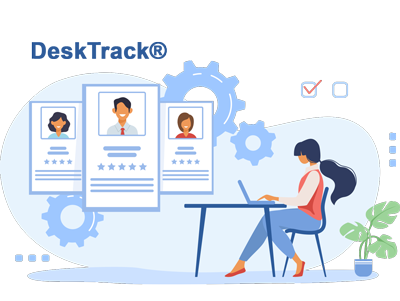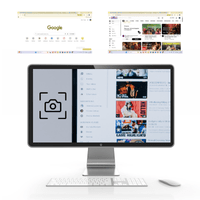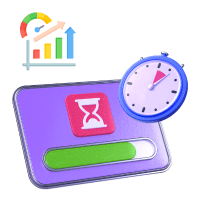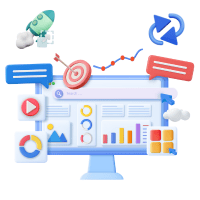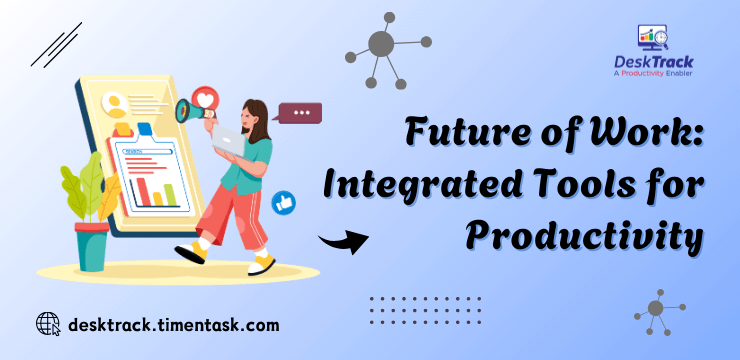
Integrated tools for productivity will have a significant impact on the future of work by mid-2025. To define the work world of today, the technology that we only imagined is now a reality. Simply put, you need to embrace technological advancements rather than despise them to smoothly run your business.
So far we have seen many benefits of implementing the right productivity tools in your business. Moreover, it’s only going to get better in the future. We can’t imagine how technology is going to redefine how businesses work operations and manage their employees to meet their objectives. So far what we know is that businesses utilizing technology are 100% more profitable than the ones that don’t.
So in today’s blog, we have in store for you why integrated tools for productivity are essential in 2025, the top 7 tools with examples, and how to implement the most ideal tool (s) in your business.
The Importance of Integrating Technology in the Workplace

The truth is that the future of work is more and more technology implementation. However, why is it so? Why do experts like us recommend utilizing technology and tools to the maximum? Here’s a revision.
1. Enhanced Workforce Management
Integrated tools for productivity not only boost efficiency, productivity, and overall business profitability but also enhance workforce management. These tools are especially useful for managing remote and hybrid teams as they are not physically present in your office.
Tools such as employee monitoring and time tracking software solutions such as DeskTrack provide features and functionalities to help you take charge of your teams. That too without micromanagement. For example, communication and collaboration tools help your remote teams to come together to:
- Share updates
- Collaborate on documents such as blogs (editing in content writing), and code merging (development)
- Conduct virtual meetings and stay on the same page.
2. Save Time & Expenses
work management tools such as time trackers and automated timesheets save valuable time and expenses. These are resources, which you would have otherwise overutilized, resulting in stress and burnout. For example:
- Since we already know that automated time trackers accurately record employee work hours, integrating them with the payroll apps and/or tools you use is highly beneficial.
- What you can do is send the work hours data directly for payroll processing, reducing the chances of errors, which indirectly decreases costs.
That was just one example of how integrated tools for productivity save time and expenses. So you can already expect what will happen if you properly utilize all these tools.
Read Also: Top 15 Benefits of Time Tracking Software for Businesses
3. More Accuracy
Using artificial intelligence tools for workplace productivity ensures more accuracy. This is in terms of:
- Better time and resource management
- Accurate attendance tracking system
- Enhanced need analysis. This can be the need for more resources, larger teams, and better equipment.
What we are hinting at is that utilizing AI-integrated tools for productivity accrues everything from data analysis and reporting to employee management and work hours tracking. That’s that. To summarize, embracing the power of these tools will increase your efficiency by at least 4 times.
4. Increased Productivity
Integrating technology in the workplace can significantly boost your productivity to new heights. It is due to increased accuracy and efficiency, which leads to higher profitability levels for your organization. Especially, if you employ global employees and teams.
5. Better Security
Integrated tools for productivity also enhance data and information security. It’s a growing requirement as cybercrime rates are increasing each year. Thus we need the best ways to secure our valuable data. What these tools do is allow automated security updates and upgrades to cope with the latest market demands. For example:
- Blockchain technology
- End-to-end encryption
- Strong authentication and authorization
- Captcha
- Biometric technology
6. Less Stress and Burnout
The future of work will also focus more than ever on reducing employee stress and burnout. Utilizing tools such as project management software ensures timely project deliverables and higher success rates. Furthermore, they simplify the management of complex tasks and projects, which reduces stress and burnout.
| Did You Know? |
| The more tools and technology a business uses, the more employee satisfaction it gets. However, it is also true that utilising the same technology too much can result in heavy loses due to employees feeling mistrusted and resigning. |
Top 7 Integrated Tools for Productivity in 2025 with Examples

So now we know how beneficial integrated tools for productivity are. However, which ones to be exact? Well, not to worry as we have got you covered with the top 7 tools, which businesses will utilize more than ever in the upcoming year.
1. AI-Powered Tools
Using AI-powered work management tools and other AI apps is more than just a trend. Implementing AI tools in your organization can give you a significant productivity boost. At least 40% within the first year of implementation as per a 2023 report by McKinsey. Moreover:
- Project delivery rates can go from 60% to 90% by utilizing AI tools.
- Organizations such as Microsoft and Google have gained up to 25% productivity increase by embracing AI capabilities.
- 70% of businesses will implement AI tools and technologies by 2025
Example: Tools such as ChatGPT and Alexa are great for extracting information on the go and solving complex problems.
2. VR & AR Work Environments
VR and AR-integrated tools for productivity have taken over, significantly enhancing the experience, satisfaction, and productivity of global teams. Your remote and hybrid employees can leverage simulated workplaces to experience an office-like atmosphere, which boosts engagement. Furthermore:
- As per a 2022 report by PwC, 79% of employees prefer using VR to train and develop reporting 4 times faster information retention than traditional methods.
- Businesses using augmented reality technologies have gained a 30% increase in productivity as employees can visualize complex data and collaborate in real-time.
- As per Deloitte, businesses using AR technology have gained 300% more RoI and a 40% employee efficiency boost
- 92% of enterprises report an increase in employee engagement due to VR and AR technology implementation.
Example: Tools such as Blender and Artzio can help you create virtual business environments such as flight simulators for training.
Read Also: How to Monitor Employee Performance Without Micromanagement?
3. Remote Collaboration Tools
We all know how many enterprises adopted the remote and hybrid model due to the pandemic and all that. This trend of implementing remote collaboration productivity tools has continued to 2025 and will remain in 2025 and beyond. Don’t believe us? We have listed below a few figures and facts for you.
- More and more businesses are adopting the hybrid work model and will continue to do so.
- As per a report by Fortune Business Insights, the remote collaboration tools market will have an estimated $105.5 billion net worth by 2027.
- As per a report by McKinsey, remote collaboration has increased productivity by 30%.
Example: Tools such as DeskTrack generate synchronized reports with a common time zone for better remote collaboration.
4. Personalization & Customization
These days, one-size-fits-all tools become outdated as soon as they hit the market. That too on a rapid scale. That’s why businesses and employees alike prefer using integrated tools for productivity, which are customizable and personalizable. Here’s why.
- As per a report by Gartner, 55% of users prefer personalization.
- Using customizable tools results in 82% of employees better understanding their workloads.
- As per a report by McKinsey, businesses are experiencing a 10-30% revenue increase due to employees being able to manage tasks as per their working style.
- Personalization in tools, software, and apps results in a 40% increase in project delivery speeds.
Example: Habit tracker apps such as Habitica let users customize the interface to suit their preferences for better results.
5. Workflow Automation & Optimization Tools
Integrating technology in the workplace for workflow automation and optimization works miracles, when it comes to saving valuable time and reducing costs. How? It’s simple.
When you automate mundane tasks and everyday workflows, you don’t have to make them again and again every time you clock in & clock out, which saves a lot of time. Here are a few more reasons you should automate and optimize workflows.
- 70% of executives reported Enhanced employee satisfaction and 20% cost reduction due to workflow automation and optimization.
- Automating workflow and tasks assists businesses in increasing productivity by up to 40%.
Example: Tools such as Automate.io let users create workflows without coding.
6. Data Security & Privacy Tools
Due to the emphasis on making even the smallest decisions based on concrete data, information security and privacy is a major concern for every business. That’s why even the most basic productivity monitoring software solutions come equipped with stringent security features. They should be because:
- As per a report by Cybersecurity Ventures, cybercrime damages will increase to a staggering $10.5 trillion per year by 2025.
- As per a Gartner report, 75% of employees reported that security in their communication tools increases trust in their employers.
Example: Tools like Securiti enhance data privacy and governance.
7. Sustainable & Green Technology Tools
Integrated tools for productivity, which are sustainable and developed with green technology will also be big in 2025. Why? The logic is simple, reducing the carbon footprint is as important as boosting employee productivity, if not more. Besides, who wouldn’t want a 150% revenue increase within just 2 years by using sustainable tools?
Example: Tools that use solar energy.
How to Implement the Best Business Productivity Tools in 2025?
To properly embrace what the technological future of work has in store for you, you need to implement the right tools for the same as per your business requirements. Fortunately, it’s very simple.
1. Requirement Analysis
Based on the requirements of your business, you may use one, a combination of, or all 7 types of integrated tools for productivity in your organization. Before anything else, you should entirely focus on your requirements such as the number of your employees and/or the systems you have.
2. Cost vs. Budget vs. RoI Analysis
Before integrating technology in the workplace, you should know that the best ones always come with a price tag. Trust us, you don’t want to go bankrupt over mindlessly spending your revenue on tools that help boost productivity and are not the only way for you to increase profitability.
- An expert tip is to check the cost of the tool (s) against your budget and whether the RoI it offers is according to your expectations.
Read Also: Time Card Calculator: All You Need to Know for 2025
3. Shortlisting
The next step is to make a list of the top integrated tools for productivity based on your requirements and cost analysis. Yes, that’s all there is to this step.
4. Utilize Free Trials
Sorting the most ideal option from your list of productivity tools requires you to test the tools to see whether they provide the expected results or not. Fortunately, free trials are available for even the most affordable tools these days.
5. Implement
Now all you have to do is slowly and steadily implement the integrated tools for productivity in your organization. This is so that your employees can easily adapt to the new change without disrupting their typical work schedules.
Conclusion
We hope that now you are clear about integrated tools for productivity and why businesses need to utilize them. As a final word, we can say that as per the trends, technology will only get more advanced in the upcoming year 2025 and beyond. Thus, businesses that embrace it will thrive, succeed, and grow. However, others who don’t will soon be thrown out of the market. Moreover, businesses need to implement the right tools and technologies as per their requirements. Otherwise, they will only waste their time. Thus, it’s important to know, what’s new and ongoing in the market and follow certain expert-recommended steps to choose the right software. So, how will these technological advancements impact the work future? We don’t know yet. However, what we do know is that implementing DeskTrack in your organization will surely maximize employee productivity.
Frequently Asked Questions (FAQ)
Q.1 What are Integrated Tools for Productivity?
Ans. Integrated tools for productivity for businesses are solutions, software, or applications that have the features and functionalities to help businesses run smoothly. Such tools seamlessly integrate with the systems in your organization to help enhance employee efficiency, automate tasks, and boost profitability for success and growth.
Q.2 What are the Benefits of Using Integrated Tools for Productivity?
Ans. Using integrated productivity tools, apps, and software solutions provides many benefits including:
- Enhanced Workforce Management
- Save Time & Expenses
- More Accuracy
- Increased Productivity
- Better Security
- Less Stress and Burnout
Q.3 How to Implement the Best Integrated Tools for Productivity?
Ans. Here’s how to choose and implement your ideal integrated tools for productivity.
- Requirement Analysis
- Cost vs. Budget vs. RoI Analysis
- Shortlisting
- Utilize Free Trials
- Implement
Q.4 Which are the Best Integrated Productivity Tools for Businesses?
Ans. Here are the top 7 tools for workplace productivity.
- AI-Powered Tools
- VR & AR Work Environments
- Remote Collaboration Tools
- Personalization & Customization
- Workflow Automation & Optimization Tools
- Data Security & Privacy Tools
- Sustainable & Green Technology Tools


